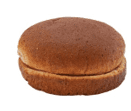Good Carbs vs. Bad Carbs
One of my favorite meals is a cheeseburger (image above) paired with a soft drink afterward. Unfortunately, a cheeseburger contains a few “bad” carbohydrates. “Bad” carbohydrates are essentially “simple” carbohydrates, meaning they are easily digested. Most of their nutrients have already been removed, so not much requires digestion. This rapid digestion leads to quick absorption into the blood, which leads to a sudden spike in blood sugar, which then later drops rapidly, causing what is known as a sugar crash (Holesh, Aslam & Martin, 2017). Notably, sudden spikes in blood sugar are a risk factor for diabetes and high blood pressure. This quick process of assimilation of these carbs in the body leaves one feeling hungry just a short while after eating, leading to a higher risk of overeating (Schiff, 2022).
Do you need help with your assignment ? Contact us.
In the case of a cheeseburger, some of the bad carbs include buns. Buns are basically white bread that contains a lot of carbohydrates. Notably, in white bread, many other essential nutrients, including proteins, fiber, vitamins, and minerals, have been stripped off. Accordingly, white bread is a highly processed meal with no other important nutrients other than carbohydrates, making it very unhealthy (Chen et al., 2020). Nevertheless, this can be made healthier by replacing the “bad” carbs with “good” carbs. One example of a “good” carb for this case is using brown bread (image below) instead of white bread.
Essentially, brown bread is rich in fiber, proteins, and minerals, which are essential nutrients. Further, fiber slows down the process of digestion, meaning that there will be a gradual absorption of carbohydrates in the blood, preventing sudden spikes in blood sugar. As brown bread is also recommended for people with diabetes (Aune et al., 2013), it affirms that my choice is the best one for my favorite meal.
References
Aune, D., Norat, T., Romundstad, P., & Vatten, L. J. (2013). Whole grain and refined grain consumption and the risk of type 2 diabetes: a systematic review and dose–response meta-analysis of cohort studies. European journal of epidemiology, 28, 845-858.
Chen, X., Zhang, Z., Yang, H., Qiu, P., Wang, H., Wang, F., … & Nie, J. (2020). Consumption of ultra-processed foods and health outcomes: a systematic review of epidemiological studies. Nutrition Journal, 19(1), 1-10.
Holesh, J. E., Aslam, S., & Martin, A. (2017). Physiology, Carbohydrates.
Schiff. W. J. (2022). Nutrition for Healthy Living. McGraw Hill.
ORDER A PLAGIARISM-FREE PAPER HERE
We’ll write everything from scratch
Question
Good Carbs vs. Bad CarbsUnit 3 DB: Good Carbs vs. Bad Carbs
Choose your favorite meal that contains at least one “bad” carbohydrate. Explain to the class what “bad” carbohydrates are in this meal. How could you make substitutions to this meal to get rid of the “bad”
Good Carbs vs. Bad Carbs
carbohydrates and replace them with “good” carbohydrates?
Be creative! You can include pictures of your before and after meals. Also, if you used a recipe, please link it so that your classmates can start building a healthy recipe library
Please review the Discussion Board Grading Criteria on the Course Information Page. .



